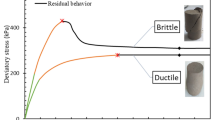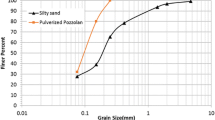Abstract
The present study investigates the use of natural pozzolana combined with lime for ground improvement applications. Laboratory tests were undertaken to study the effect of natural pozzolana, lime or a combination of both on the physical and the mechanical characteristics of cohesive soils. Natural pozzolana, lime and natural pozzolana-lime were added to two cohesive soils at ranges of 0–20 and 0–8%, respectively. Consistency, compaction, undrained traxial shear and unconfined compressive strength tests were performed on untreated and treated soil samples to assess the physical and mechanical characteristics of the soil. Treated samples were cured for 1, 7, 28 and 90 days. The results show that the cohesive soils can be successfully stabilized by combining natural pozzolana and lime.






Similar content being viewed by others
References
Al-Rawas AA, Goosen MFA (2006) Expansive soils-Recent advances in characterization and treatment. London, Taylor & Francis group
Al-Rawas AA, Hago AW, Al-Sarmi H (2005) Effect of lime, cement and sarooj (artificial pozzolan) on the swelling potential of an expansive soil from Oman. Build Environ 40:681–687
Ansary MA, Noor MA, Islam M (2006) Effect of fly ash stabilization on geotechnical properties of Chittagong coastal soil. In soil stress-strain behavior geotechnical symposium
ASTM D4318 (2000) Standard test methods for liquid limit, plastic limit, and plasticity index of soils. ASTM International
ASTM D698 (2000) Standard test methods for laboratory compaction characteristics of soil using standard effort. ASTM International
ASTM D2166 (2000) Standard test methods for unconfined compressive strength of cohesive soil. ASTM International
ASTM D2850 (2003) Standard test methods for unconsolidated-undrained triaxial compression test on cohesive soils. ASTM International
Attoh-Okine NO (1995) Lime treatment of laterite soils and gravels-revisited. Construct Build Mater 9:283–287
Bagherpour I, Choobbasti AJ (2003) Stabilization of fine-grained soils by adding micro silica and lime or micro silica and cement. Electron J Geotech Eng 8:1–10
Basha EA, Hashim R, Muntohar AS (2003) Effect of the cement-rice husk ash on the plasticity and compaction of soil. Electron J Geotech Eng 8:1–8
Basha EA, Hashim R, Mahmud HB, Muntohar AS (2005) Stabilization of residual soil with rice husk ash and cement. Construct Build Mater 19:448–453
Bell FG (1996) Lime stabilization of clay minerals and soils. Eng Geol 42:223–237
Chen L, Lin DF (2009) Stabilization treatment of soft subgrade soil by sewage sludge ash and cement. J Hazard Mater 162:321–327
Gay G, Schad H (2000) Influence of cement and lime additives on the compaction properties and shear parameters of fine grained soils. Otto-Graf J 11:19–31
George SZ, Ponniah DA, Little JA (1992) Effect of temperature on lime-soil stabilization. Construct Build Mater 6:247–252
Ghrici M, Kenai S, Said Mansour M (2007) Mechanical properties and durability of mortar and concrete containing natural pozzolana and limestone blended cements. Cem Concr Compos 29:524–549
Goswami RK, Singh B (2005) Influence of fly ash and lime on plasticity characteristics of residual lateritic soil. Ground Improv 9:175–182
Guney Y, Sari D, Cetin M, Tuncan M (2007) Impact of cyclic wetting-drying on swelling behaviour of lime-stabilized soil. Build Environ 42:681–688
Hossain KMA, Lachemi M, Easa S (2007) Stabilized soils for construction applications incorporating natural resources of Papua New Guinea. Resour Conserv Recycling 51:711–731
Kalkan E (2009) Influence of silica fume on the desiccation cracks of compacted clayey soils. Appl Clay Sci 43:296–302
Kavak A, Akyarli A (2007) A field application for lime stabilization. Env Geol 51:987–997
Kolias S, Kasselouri-Rigopoulou V, Karahalios A (2005) Stabilization of clayey soils with high calcium fly ash and cement. Cem Concr Compos 27:301–313
Lasledj A, Al-Mukhtar M (2008) Effect of hydrated lime on the engineering behaviour and the microstructure of highly expansive clay. In: International conference on computer methods and advances in geomechanics
Lin DF, Lin KL, Hung MJ, Luo HL (2007) Sludge ash/hydrated lime on the geotechnical properties of soft soil. J Hazard Mater 145:58–64
Manasseh J, Olufemi AI (2008) Effect of lime on some geotechnical properties of Igumale shale. Electron JGeotech Eng 13:1–12
Muntohar AS, Hantoro G (2000) Influence of rice husk ash and lime on engineering properties of a clayey subgrade. Electron J Geotech Eng 5:1–9
Nalbantoglu Z (2004) Effectiveness of class C fly ash as an expansive soil stabilizer. Construct Build Mater 18:377–381
Nalbantoglu Z (2006) Lime stabilization of expansive clay. In: Al Rawas AA, Goosen MFA (eds) Expansive soils-recent advances in characterization and treatment. London, Taylor & Francis group, pp 341–348
Okagbue CO, Yakubu JA (2000) Limestone ash waste as a substitute for lime in soil improvement for engineering construction. Bull Eng Geol Environ 58:107–113
Ola SA (1977) The potentials of lime stabilization of lateritic soils. Eng Geol 11:305–317
Osula DOA (1996) A comparative evaluation of cement and lime modification of laterite. Eng Geol 42:71–81
Parsons RL, Kneebone E (2005) Field performance of fly ash stabilized subgrade. Ground Improv 9:33–38
Prabakar J, Dendorkar N, Morchhale RK (2004) Influence of fly ash on strength behavior of typical soils. Construct Build Mater 18:263–267
Rahman MDA (1986) The potentials of some stabilizers for the use of lateritic soil in construction. Build Environ 21:57–61
Senol A, Edil TB, Bin-Shafique MS, Acosta HA, Benson CH (2006) Soft subgrades’ stabilization by using various fly ashes. Resour Conserv Recycling 46:365–376
Sezer A, Inan G, Yilmaz HR, Ramyar K (2006) Utilization of a very high lime fly ash for improvement of Izmir clay. Build Environ 41:150–155
Author information
Authors and Affiliations
Corresponding author
Rights and permissions
About this article
Cite this article
Harichane, K., Ghrici, M., Kenai, S. et al. Use of Natural Pozzolana and Lime for Stabilization of Cohesive Soils. Geotech Geol Eng 29, 759–769 (2011). https://doi.org/10.1007/s10706-011-9415-z
Received:
Accepted:
Published:
Issue Date:
DOI: https://doi.org/10.1007/s10706-011-9415-z




